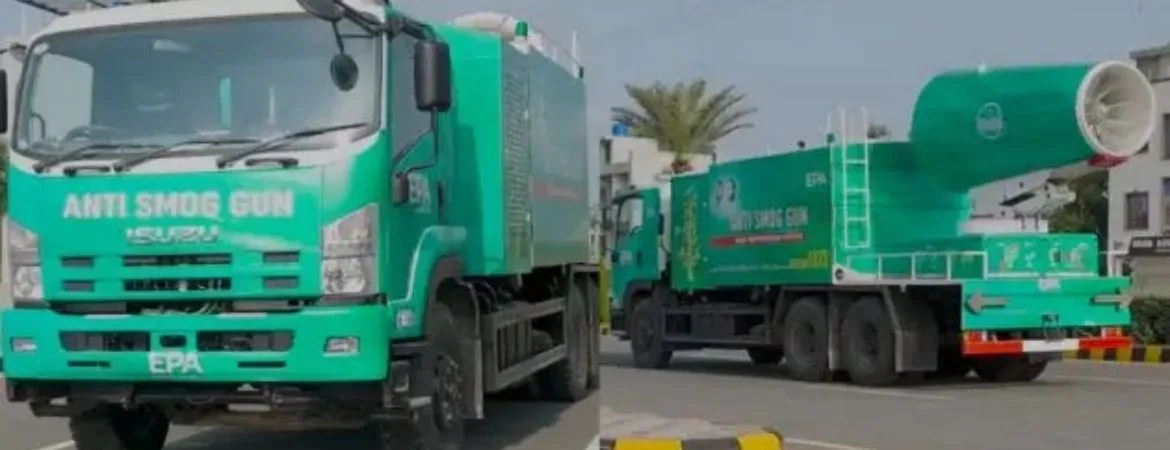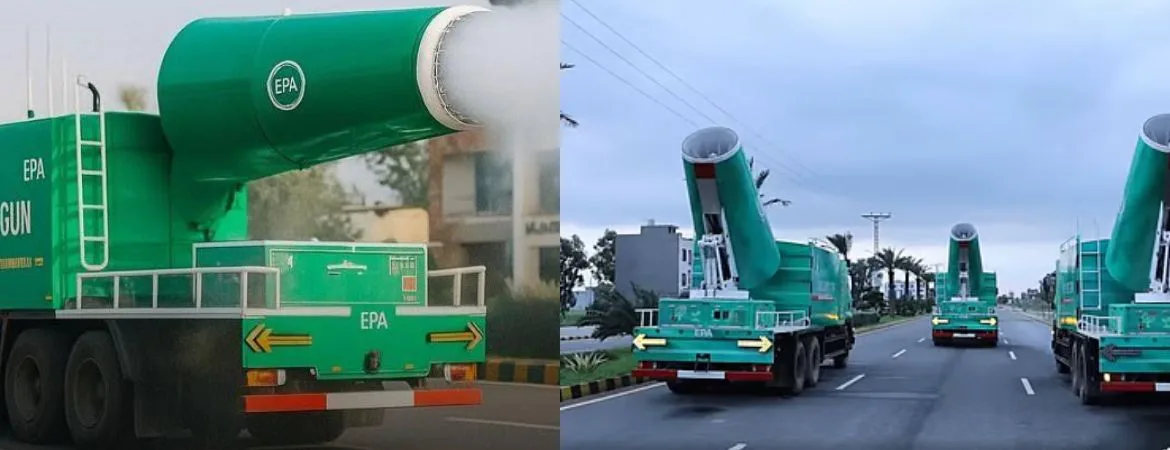
Punjab has declared war against smog by opening anti-smog cannons in Lahore. These cannons are used to spray the atmosphere in order to remove harmful particles that contaminate the air. Because every year smog leads to school closures, traffic issues, and hospitals full of patients who cannot breathe.
The government, under the administration of the chief minister, Maryam Nawaz, has implemented these mist spraying machines in Lahore, as well as other cities in the Punjab to reduce the pollution as well as to enhance the air quality. Although this high-tech move is a great step forward, there are still questions as to how effective such cannons will be and what still needs to be done to assist Punjab.
Taking a tougher approach towards the issue of air pollution, Chief Minister Maryam Nawaz has ordered the operation of these smog cannons as the second stage of a broader anti-smog movement. According to her, it is not only a battle against cleaner skies, but it is also a battle against the health and future of our people.
It has a capacity to produce the mist up to 100 meters in the air and is linked to a water tanker with a capacity of 16,000 litres. The fine water droplets are mini magnets – they combine with dust, soot and other harmful substances like PM2.5 and drag them into the ground.
This has so far resulted in the building of 15 cannons locally, with another five in progress. The officials claim that it is not merely an effort to combat smog, but to demonstrate local innovation in addressing environmental disasters. An Environmental Protection Agency official said, We are developing our own solutions. This is Pakistani engineering, designed to suit Pakistani conditions.
The science of the smog cannon is simple yet interesting. Smog is made up to a large extent of fine particulate matter, which is finely suspended particles that are suspended in the air. When mist is sprayed by a smog cannon, the ultrafine water droplets collide with it, hence uniting them into even heavier clumps that drop to the ground due to gravity.
The mist is in an artificial rain. Such an approach does not prevent a source of pollution but instead decreases its level in the short-term, which provides citizens with short-term relief, and in particular, on the most risky days when the Air Quality Index (AQI) reaches levels exceeding 300.
According to environmental experts, these cannons cannot resolve the issue in the long term, but they can be very important when they are combined with long-term pollution control policies. The integration is the key as the way to reducing the highest points of pollution by using these machines in the areas of pollution hot spots, like roads with heavy traffic, industrial areas and construction corridors.
The smog crisis in Lahore has become alarming in recent years. It used to be called the City of Gardens, but is currently frequently listed among the most polluted cities of the world in winter. AQI levels are usually higher than 400, which is way above the dangerous mark.
The smog in Lahore is not made up of just a single thing- it is a poisonous blend of vehicle pollutants, industrial smog, trash and crop burning, construction dust and the emissions of brick kilns. The geography of the city worsens the situation. Lahore is in a basin-like plain, and it inverts temperature in the winter: warm air holds pollutants close to the ground, where it is unable to scatter.
This leads to smog layers, and day becomes night. The visibility reduces to almost zero, planes are cancelled, and roads are unsafe. Breathing becomes a struggle for many residents. Recent reports indicate that approximately two million individuals in Punjab also sought medical services related to smog last year in a single month. Lahore had more than 100,000 such cases. The statistics are depressing and a sign of a public health crisis in slow motion.

Although the headlines have focused on the fog cannon fleet, it is only a component of a larger data-driven anti-smog effort. The government of Punjab is employing a multi-layered approach to address the problem of pollution at all angles.
The province has established 43 new air quality monitoring stations in large cities. These devices will give instant information on the level of pollutants, and this will enable officials to detect the peak of pollution and respond immediately. The information is also distributed to the citizens so as to enhance awareness and openness- a major step towards being collectively responsible.
The EPA has increased its inspections of the brick kilns, imposing bans on the illegally operating ones or those that use outdated technology. At the same time, fires of garbage burning and crop residue, which are two of the leading contributors to smog, are also being addressed by fines, awareness programs among farmers, and alternative disposal processes.
The city teams under the banner of Suthra Punjab (Clean Punjab) are being deployed to sprinkle dusty roads, open construction sites, and otherwise clean up the world. This initiative aims to reduce dust emissions and improve visibility in urban centres.
In order to curb open-air pollution, the government has made it illegal to smoke in open parks and recreational places. There are more frequent advisories issued by health departments, which are urging their citizens to wear masks and keep indoor activity to a minimum in cases of high smog alerts.
The most futuristic move in this campaign is, perhaps, the incorporation of AI-based satellite and drone surveillance. These systems will recognize the burst of pollution, the hotspots of burning, and automatically initiate preventive action such as the use of smog cannons or the notification of the enforcement teams.
Other countries, such as China and India, have tried using such technologies. Fog cannons were first introduced at the Beijing Olympics as a way of controlling construction dust in China, and were later extended in times of extreme smog. India has come up with the same, as mobile and stationary smog guns have been deployed in Delhi and Gurugram.
There is a local twist to the Punjab version, though: home-made cannons and AI-controlled deployment. The strategy is indicative of an emerging trend in Pakistan of sustainable, technology-focused governance, a cross-disciplinary area of environmental science, social and human health, and change of innovations. But the experts note that these cannons are not a silver bullet. They give some relief but not a lasting reform. It will only take a real transformation that will bring down emissions at the source.
The million-rupee question is whether these devices will produce a significant change.

Chief Minister Maryam Nawaz has placed the anti-smog movement as a component of a broader climate resilience agenda. The vision of her administration is to not only fight seasonal smog but also to prepare for sustainable urban living.
The government is also looking into renewable energy initiatives, tree-planting campaigns and urban forestation to bring back the lost green cover in Lahore. All of these measures, along with greener industry operations and even more intelligent urban planning, would slowly put the weight on cleaner air all year round.
The key to the campaign is still public participation. They urge their citizens to:
Smog emergency counters are also being established in the hospitals to handle cases of respiratory issues, and students are being advised to check on their health and also go online on the red-alert days.
The Eastern Housing Lahore project and Eastern City Walk are assisting Punjab in attaining its clean air and environmental objectives based on sustainable urban design. The objective of these projects is to reduce vehicle pollution by establishing residential communities where individuals will not commute long distances to workplaces, shops and parks.
They helped investors to get residential and commercial areas with wide green belts, tree lined roads, safe walking and cycling paths to ensure a healthy and luxurious lifestyle. Their main focus is to introduce solar lights, energy efficient buildings and proper waste management systems to limit pollution. Through modern design and concern towards the environment, they are helping the vision of a Clean and Green Punjab.
Punjab’s launch of smog cannons in Lahore is a heavy measure to deal with air pollution. The problem of air pollution in Lahore is a long-term and permanent issue. But this anti smog cannon project assists in providing temporary relief.
The real change will require long-term efforts, effective rules and laws to make the air cleaner with the help of technology and people’s cooperation. If this plan works, then Lahore might finally be able to clear the contaminated skies during winter. A clear environment will help to reduce the visits to hospitals. Otherwise, the anti-smog cannons can become one more expensive effort without results.
Lorem ipsum dolor sit amet, consectetur adipiscing elit. Ut elit tellus, luctus nec ullamcorper mattis, pulvinar dapibus leo.
Information
© ALL RIGHTS RESERVED | A PROJECT OF MAS Group